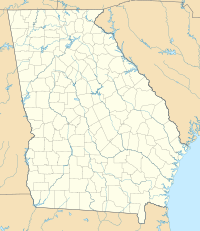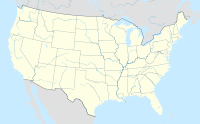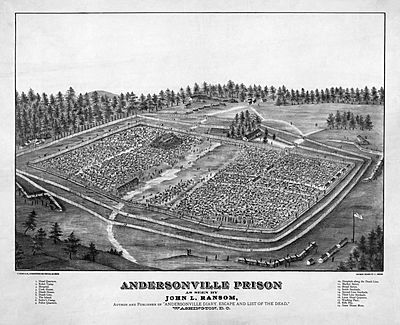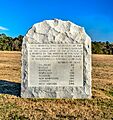Andersonville Prison facts for kids
|
Andersonville National Historic Site
|
|
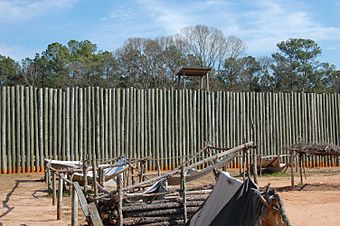
Reconstruction of a section of the stockade wall
|
|
| Location | Macon / Sumter counties, Georgia, United States |
|---|---|
| Nearest city | Andersonville, Georgia, Americus, Georgia |
| Area | 514 acres (208 ha) |
| Visitation | 1,436,759 (2011) |
| Website | Andersonville National Historic Site |
| NRHP reference No. | 70000070 |
Quick facts for kids Significant dates |
|
| Added to NRHP | October 16, 1970 |
| Designated NHS | October 16, 1970 |
The Andersonville National Historic Site, located near Andersonville, Georgia, preserves the former Andersonville Prison (also known as Camp Sumter), a Confederate prisoner-of-war camp during the final fourteen months of the American Civil War. Most of the site lies in southwestern Macon County, adjacent to the east side of the town of Andersonville. The site also contains the Andersonville National Cemetery and the National Prisoner of War Museum. The prison was created in February 1864 and served until April 1865.
The site was commanded by Captain Henry Wirz, who was tried and executed after the war for war crimes. The prison was overcrowded to four times its capacity, and had an inadequate water supply, inadequate food, and unsanitary conditions. Of the approximately 45,000 Union prisoners held at Camp Sumter during the war, nearly 13,000 (28%) died. The chief causes of death were scurvy, diarrhea, and dysentery.
Contents
Conditions
The prison, which opened in February 1864, originally covered about 16.5 acres (6.7 ha) of land enclosed by a 15-foot (4.6 m) high stockade. In June 1864, it was enlarged to 26.5 acres (10.7 ha). The stockade was rectangular, of dimensions 1,620 feet (490 m) by 779 feet (237 m). There were two entrances on the west side of the stockade, known as "north entrance" and "south entrance". This allows for a space of about 5 feet by 6 feet (1.5 x 2 m) for each prisoner.
The dead line
At Andersonville, a light fence known as "the dead line" was erected approximately 19 ft (5.8 m) inside the stockade wall. It demarcated a no-man's land that kept prisoners away from the wall, which was made of rough-hewn logs about 16 ft (4.9 m) high and stakes driven into the ground. Anyone crossing or even touching this "dead line" was shot without warning by sentries in the guard platforms (called "pigeon roosts") on the stockade. (It is considered possible, although not established, that the modern term deadline in the sense of a time limit derives from this.)
Survival and social networks
At the time of the Civil War, the concept of a prisoner of war camp was still new. It was not until 1863 that President Lincoln demanded a code of conduct be instituted to guarantee prisoners of war an entitlement to food and medical treatment and to protect them from enslavement and murder. Andersonville did not provide its occupants with these guarantees; the prisoners at Andersonville, without any sort of law enforcement or protections, functioned more closely to a primitive society than a civil one. As such, survival often depended on the strength of a prisoner's social network within the prison. A prisoner with friends inside Andersonville was more likely to survive than a lone prisoner. Social networks provided prisoners with food, clothes, shelter, moral support, trading opportunities and protection against other prisoners. One study found that a prisoner having a strong social network within Andersonville "had a statistically significant positive effect on survival probabilities, and that the closer the ties between friends as measured by such identifiers as ethnicity, kinship and the same home town, the bigger the effect."
The Raiders
A group of prisoners, calling themselves the Andersonville Raiders, attacked their fellow inmates to steal food, jewellery, money and clothing. Another group started up, organized by Peter "Big Pete" Aubrey, to stop the larceny, calling themselves "Regulators". They caught nearly all of the Raiders, who were tried by the Regulators' judge, Peter McCullough, and a jury, selected from a group of new prisoners. This jury, upon finding the Raiders guilty, set punishment that included running the gauntlet, being sent to the stocks, ball and chain and, in six cases, hanging.
The conditions were so poor that in July 1864, Captain Henry Wirz paroled five Union soldiers to deliver a petition signed by the majority of Andersonville's prisoners asking that the Union reinstate prisoner exchanges to relieve the overcrowding and allow prisoners to leave these terrible conditions. That request was denied. The petitioners, who had sworn to return, reported this to their comrades.
Deaths
During the war, 45,000 prisoners were received at Andersonville prison; of these nearly 13,000 died. The nature and causes of the deaths are a source of controversy among historians. Some contend that the deaths resulted from Confederate policy and were war crimes against Union prisoners, while others state that they resulted from disease promoted by severe overcrowding; the widespread food shortage in the Confederate States; the prison officials' incompetence; and the breakdown of the prisoner exchange system, caused by the Confederacy's refusal to include black Union troops in the exchanges. The stockade became severely overcrowded.
During the war, disease was the primary cause of death in both armies. Infectious disease was a chronic problem, due to poor sanitation in regular as well as prison camps.
Dorence Atwater
A young Union prisoner, Dorence Atwater, was chosen to record the names and numbers of the dead at Andersonville, for use by the Confederacy and the federal government after the war ended. He believed, correctly, the federal government would never see the list. Therefore, he sat next to Henry Wirz, who was in charge of the prison pen, and secretly kept his own list among other papers. When Atwater was released, he put the list in his bag and took it through the lines without being caught. It was published by the New York Tribune when Horace Greeley, the paper's owner, learned the federal government had refused the list and given Atwater much grief. Atwater believed that the commanding officer Wirz had been trying to ensure that Union prisoners would be rendered unfit to fight if they survived the prison.
Newell Burch
Prisoner of war (POW) Newell Burch also recorded Andersonville's poor conditions in his diary. A member of the 154th New York Volunteer Infantry, Burch was captured on the first day of the Battle of Gettysburg; he was first imprisoned at Belle Isle in Richmond, Virginia and then Andersonville. He is credited with having been the longest-held Union prisoner of war during the Civil War, having survived a total of 661 days in Confederate hands. His diary is in the collection of the Dunn County Historical Society in Menomonie, Wisconsin; a mimeographed copy is held by the Wisconsin Historical Society.
Prisoner population
| Date | Population |
|---|---|
| April 1, 1864 | 7,163 |
| May 5, 1864 | 12,002 |
| June 13, 1864 | 20,654 |
| June 19, 1864 | 23,944 |
| July 18, 1864 | 29,078 |
| July 31, 1864 | 31,680 |
| August 31, 1864 | 31,695 |
Escapes
Planning an escape from this camp was routine among the thousands of prisoners. Most men formed units to burrow out of the camp using tunnels. The locations of the tunnels would aim towards nearby forests fifty feet from the wall. Once out, escape was nearly impossible due to the poor health of prisoners. Prisoners caught trying to escape were denied rations, chain ganged, or killed. Playing dead was another method of escape. Prisoners would pretend to be dead and carried out to the row of dead bodies outside of the walls. As soon as night fell the men would get up and run. Once Wirz learned of this practice he ordered an examination by surgeons on all bodies taken out of the camp.
Confederate records show that 351 prisoners (about 0.7% of all inmates) escaped, though many were recaptured. The US Army lists 32 as returning to Union lines; of the rest, some likely simply returned to civilian life without notifying the military, while others probably died.
Confederacy's offer to release prisoners
In the latter part of the summer of 1864, the Confederacy offered to conditionally release prisoners if the Union would send ships to retrieve them (Andersonville is inland, with access possible only via rail and road). In the autumn of 1864, after the Battle of Atlanta, all the prisoners who were well enough to be moved were sent to Florence Stockade (near Florence, South Carolina) and Camp Lawton (near Millen, Georgia). At Millen, better arrangements prevailed, and prisoners were transported by rail to the port of Savannah. After General William Tecumseh Sherman began his march to the sea and destroyed Millen, the remaining prisoners were returned to Andersonville.
Liberation
Andersonville Prison was liberated by the Union Army in May 1865, with the prisoners inside being found and described as "human skeletons amid hellish scenes of desolation".
Trial
After the war, Henry Wirz, commandant of the inner stockade at Camp Sumter, was tried by a military tribunal on charges of war crimes. The trial was presided over by Union General Lew Wallace and featured chief Judge Advocate General (JAG) prosecutor Norton Parker Chipman.
A number of former prisoners testified about conditions at Andersonville, many accusing Wirz of specific acts of cruelty. The court also considered official correspondence from captured Confederate records. Perhaps the most damaging was a letter to the Confederate surgeon general by James Jones, who in 1864 was sent by Richmond to investigate conditions at Camp Sumter. Jones had been appalled by what he found, and reported he vomited twice and contracted influenza from the single hour he'd toured the camp. His graphically detailed report to his superiors all but closed the case for the prosecution.
Wirz presented evidence that he had pleaded to Confederate authorities to try to get more food and that he had tried to improve the conditions for the prisoners inside. He was found guilty, and sentenced to death. On November 10, 1865, he was hanged. Wirz was one of three men executed after the war for war crimes and the only Confederate official; the others were guerrillas Champ Ferguson and Henry C. Magruder. The revelation of the prisoners' sufferings was one of the factors that affected public opinion in the North regarding the South after the close of the Civil War.
Contrary to common belief, Wirz was not the only person prosecuted for his actions at Andersonville. James Duncan, who had worked in the quartermaster's office at Camp Sumter, was convicted of manslaughter for allegedly withholding food from some of the prisoners. Duncan had previously been called as a defense witness for Wirz, but was arrested when he arrived to give evidence.
Aftermath
In 1890, the Grand Army of the Republic (GAR), Department of Georgia, bought the site of Andersonville Prison through membership and subscriptions. It found that as their number was growing less year by year, and as it required a great deal of money to keep up the place, it would be better for them to offer it to the Woman's Relief Corps (WRC), the auxiliary to the GAR.
When the WRC was in annual session in St. Paul, Minnesota, in 1896, representatives of the Georgia GAR came before them, and offering the old prison, asked them to accept the gift and keep it from desecration. The women accepted it as a sacred trust, and immediately appointed Lizabeth A. Turner , as chairman of a board to beautify the grounds and make a park of them. A house for a caretaker was needed, and as the women did not want to build it within the old stockade, more land was purchased making the acreage within the enclosure about 87 acres (35 ha). A ten-room house was erected, a caretaker installed, and then the tedious process of making a park was begun. Bermuda grass was planted root by root, a pear and pecan orchard set out, and a rose garden planted, with rose bushes sent from almost every state in the Union. Several states were given ground upon which to erect monuments to their dead soldiers. These were Massachusetts, Ohio, Michigan, Rhode Island, and Wisconsin. Turner having died while in discharge of her duty, the WRC also erected a monument to her memory in the park.
In 1910, the site was donated by the WRC to the federal government. In the following year, the memorial tablet set up by the donors was unveiled. Upon the tablet are the names of the incorporators of the WRC as well as the names of the Board of Trustees for 1909-10, and the names of the committee on transfer to the government.
National Prisoner of War Museum
The National Prisoner of War Museum opened in 1998 as a memorial to all American prisoners of war. Exhibits use art, photographs, displays, and video presentations to depict the capture, living conditions, hardships, and experiences of American prisoners of war in all periods. The museum also serves as the park's visitor center.
Andersonville National Cemetery
The cemetery is the final resting place for the Union prisoners who died while being held at Camp Sumter/Andersonville as POWs. The prisoners' burial ground at Camp Sumter has been made a national cemetery. It contains 13,714 graves, of which 921 are marked "unknown".
As a National Cemetery, it is also used as a burial place for more recent veterans and their dependents.
Visitors can walk the 26.5-acre (10.7 ha) site of Camp Sumter, which has been outlined with double rows of white posts. Two sections of the stockade wall have been reconstructed: the north gate and the northeast corner.
Depictions
- Andersonville (1955) is a novel by MacKinlay Kantor concerning the Andersonville prison. It won the Pulitzer Prize for Fiction in 1956.
- The Andersonville Trial (1970), a PBS television adaptation of a 1959 Broadway play. It depicts the 1865 trial of Andersonville commandant Henry Wirz.
- The Italian western comics series “Tex” includes a three-volumes episode set in the imaginary prisoner-of-war camp Anderville during the American civil war, which is based upon Andersonville.
- The TV movie Andersonville (1996), directed by John Frankenheimer, tells the story of the notorious Confederate prison camp.
- Max R. Terman's Hiram's Honor: Reliving Private Terman's Civil War (2009, Hillsboro, KS: TESA Books, ISBN: 0-615-27812-4), is an historical novel.
- A novel written in 2014 by Tracy Groot entitled The Sentinels of Andersonville depicts some of the Historical players such as Capt. Henry Wirz and General John Winder and fictional prisoners in Andersonville Prison as rebel neighbors, attempting to help the prisoners, were vilified by the town of Americus, GA.
Gallery
Monuments
See also
 In Spanish: Sitio Histórico Nacional de Andersonville para niños
In Spanish: Sitio Histórico Nacional de Andersonville para niños


